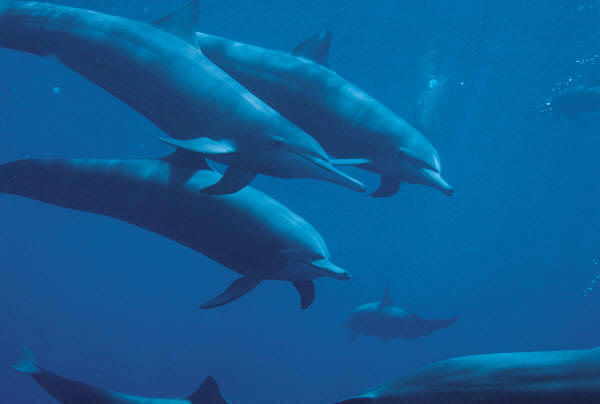
Spinner dolphins feed at night, usually in large groups that require much communication and coordination, although individual hunting is not uncommon in inshore areas. These mammals are carnivorous, eating mostly fish, squid, shrimp, and other mesopelagic prey. It has been estimated that the energy needs of a Spinner dolphin this size, without considering possible growth costs, were estimated at 2,440 kcal per day. This study also suggested that they need to consume an estimated minimum of 1.25 large prey items per minute to meet their maintenance needs. (K.J. Benoit-Bird) Dolphins use their incomparable ability to communicate by echolocation and visuals to locate prey and converse with other members of the pod. Working together as a team, the Spinners surround their prey, compress them into a smaller area, and continue to lead them towards the surface whe
 re
there is little room for escape; this is where the attack happens. Usually,
dolphins swallow the prey head first. If the prey is to large to stay intact,
the dolphins will help each other tear it apart or rub it on the seafloor.
Dolphins all around the world have also taken advantage of human fishing and
have learned to follow the ships to capture any unwanted or misplaced prey.
While the group feedings are most common among dolphins, there are also
instances when they will hunt individually. Parents will teach their babies how
to hunt for their food at a very young age and eventually Spinner dolphins will
become exceptional at locating their meals.
re
there is little room for escape; this is where the attack happens. Usually,
dolphins swallow the prey head first. If the prey is to large to stay intact,
the dolphins will help each other tear it apart or rub it on the seafloor.
Dolphins all around the world have also taken advantage of human fishing and
have learned to follow the ships to capture any unwanted or misplaced prey.
While the group feedings are most common among dolphins, there are also
instances when they will hunt individually. Parents will teach their babies how
to hunt for their food at a very young age and eventually Spinner dolphins will
become exceptional at locating their meals.
This page was created by Sally Johnson